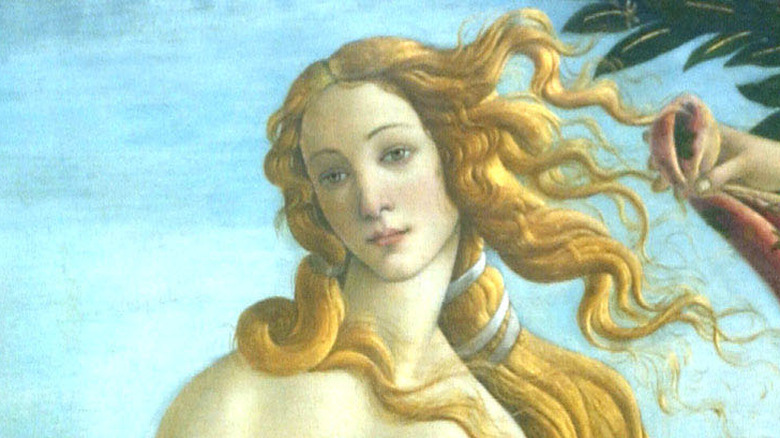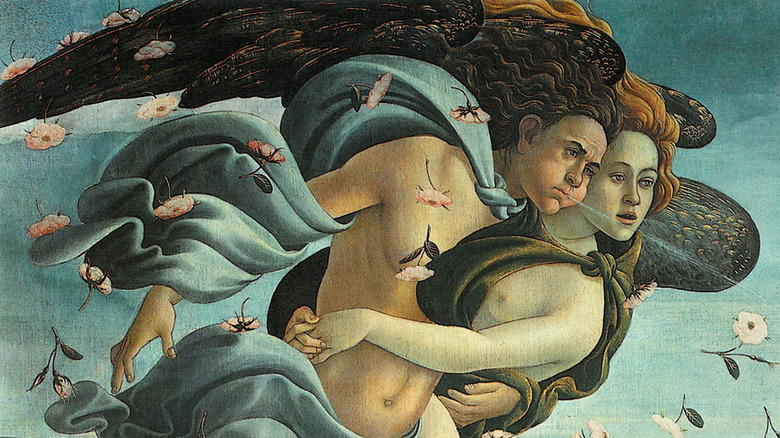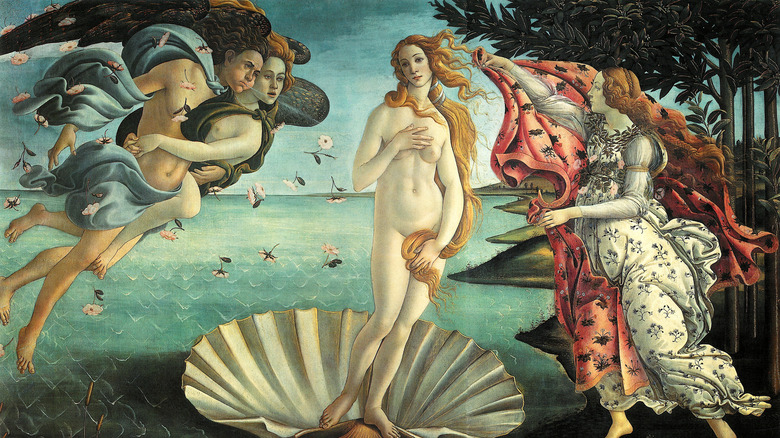Botticelli's Tradition-Smashing Birth Of Venus' Lasting Effect On Pop Culture
”The Birth of Venus,” completed in 1485 by the Early Renaissance painter Sandro Botticelli is easily one of the world's most iconic paintings. When it was first unveiled, ”The Birth of Venus” captivated the attention of the upper echelons of Florentine's high society (per Britannica).
Although Botticelli was revered in his own lifetime, it's unlikely he could fathom just how popular and enduring this painting would be to the test of time. A devout Christian himself, Botticelli's ”The Birth of Venus” encapsulates the ideologic shift from the Middle Age's preoccupation with the Divine to humanity's fascination with its own ingenuity and free will (per Art in Context).
With the powers of hindsight, it's remarkable to consider how Boticelli's painting foreshadowed not only the humanist values of the later Enlightenment period, but also modernism, and even post-modern art notions that society still juggles with today.
Before ”The Birth of Venus,” philosophy and science were already on the frontlines of fierce moralistic debate, yet art hadn't quite grappled with these heavy questions. In Botticelli's time, the bulk of painters were commissioned to paint Biblical motifs or portraits of powerful people. Instead, with ”The Birth of Venus,” though the painting is believed to have been commissioned by a member of the powerful Medici family, per Art in Context, Botticelli strayed from portraying overtly Christian imagery.
By holding a torch up to the human form, and casting it in a way where no shame or sin was stuck to its naked skin, Botticelli managed to celebrate the human form and its divinities with ”The Birth of Venus.” Yet, what is it that makes it so special?
Merging Mythologies
Those who are familiar with pagan mythologies may identify the artwork as depicting the time when the newly-born Venus arrives in Cyprus on a massive shell. To her left, Zephyr the West Wind and his wife Chloris, the nymph goddess of flowers, are blowing their breaths to sweep Venus ashore, while roses with golden hearts fall from the sky.
To Venus' right, stands The Hora of Spring, a Greek goddess who embodies the virtues of the season. She is brandishing a vibrant cloak to clothe Venus as she comes ashore (per Arts & Culture Google). Countless scholars have combed through this painting over the centuries to uncover the meanings behind all the minute details of Botticelli's paintings and have drawn some interesting parallels.
The shell Venus is going to walk off of is a profoundly symbolic feature in this painting and a potent symbol in Early Christian thought, since it is understood to symbolize resurrection. However, in pre-Christian communities, the shell became associated with fertility or even female genitalia (via ” The Continuum Encyclopaedia of Symbols”). By choosing such a hyperreal subject matter soaked in mythology, playing with its symbolism, and questioning how they fit within the prism of Christianity, Botticelli actually touched upon something ground-breaking that later modernist art movements would experiment with centuries later.
The Birth of Venus is still relevant
It's important to keep in mind, that ”The Birth of Venus” was truly the first time a painting contained a nude female that wasn't Biblical. With this painting, Botticelli is also challenging societal expectations of where the female form belonged in the art of his day. After all, plenty of naked male statues survive that use the male form to display wisdom or heroism, yet the naked female form with the ”Venus Pudica" was often unfairly connected with Eve and sin (via Art UK). Botticelli's depiction of Venus has invited many theories as to its meaning, per Art in Context, but regardless of differing opinions, the painting has remained a mainstay in pop culture.
The influence of "The Birth of Venus" can still be seen in various modes of media and social life today including in fashion, books, TV, film, music, and even cosmetics, according to Sotheby's, who writes that the 700-year-old painting is an "enduring icon of feminine splendor." Iconic pop culture staples from "Monty Python" to "James Bond" films have put their spin on it, as has Andy Warhol and Beyoncè.
Per Artsy, while the painting's lasting appeal has to do with the beauty of the feminine form, that notion has also been called out for being racist or sexist in regard to the beauty standards of today. Still, according to a press release from the Victora and Albert Museum, Botticelli's paintings, including "The Birth of Venus" has "suffused itself into our collective visual memory."


